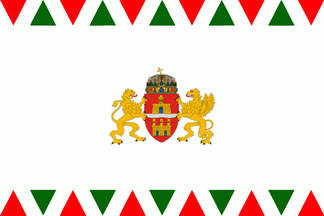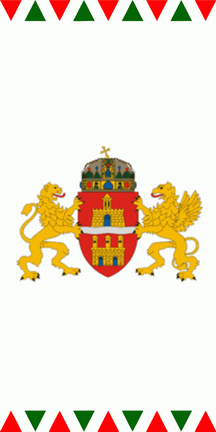
image by Zoltan Horvath, 31 December 2011

Last modified: 2025-01-18 by zoltán horváth
Keywords: hungary | budapest | buda | pest | lion | castle | danube |
Links: FOTW homepage |
search |
disclaimer and copyright |
write us |
mirrors

image by Zoltan Horvath, 31 December 2011
See also:
Other Sites:
The new mayor of Budapest has abandoned the usage of flag and coat of arms of
Budapest - reported yesterday, 24 February 2010. He said - "I do not like the
former flag of the capital, we will change it." In fact all Budapest flags were
removed from the Assembly Hall, and they were replaced with national flags. A
similar situation has occured with Budapest coat of arms, it was replaced by
Hungarian coat of arms in the Hall. "Symbols of Budapest emphasized the
independence of the capital." A representative of Budapest said "It is not a
political issue, there is a personal sense of taste. The current leadership do
not like the red-yellow-blue flag." An other official said: "There is no any
plan to design a new flag and symbols for Budapest."
My note: The problem is the similarity with the Romanian flag, both flags have
the same colours, but in different design. There is a long debate in midst of
Hungarian politicians in this issue.
This is the original article published yesterday (in Hungarian):
http://www.origo.hu/itthon/komment/20110224-tarlos-istvan-lecserelne-a-fovaros-zaszlajat.html?cmnt_page=1
I have not found any English article yet, but I think English-news bodies needs
some time to translate and publish it.
There is official page for Budapest (in English):
http://english.budapest.hu/Engine.aspx
and a Hungarian but English-language online newspaper:
http://www.budapesttimes.hu/
Within some days, we can read this news in English as well.
I do not want to state any political issue, but I can tell you that Hungarian
mid-right parties always have problem with this flag because of similarity with
Romanian colours. It is a national issue, a kind of sensitiveness, and indeed
you are right, it goes back to time between the two World Wars in the last
century.
Hungarian politicians (specially from the conservative and right side) always
suffering from memories of Trianon Treaty in 1920 when Hungary lost most of its
former territories. Romania is a sensitive issue, because a lot of people with
Hungarian nationality live in current Romania, but they lived within the
Hungarian borders before the First World War. The latest idea from this new
government to give citizenship and a suffrage for all Hungarian nationals
outside the Hungary. Neighbouring government have not been happy with this.
Going back to this issue, some political leaders do not want to any similarity
with neighbouring countries symbols. They recognize only Hungarian or
Hungarian-like symbols.
Zoltan Horvath, 25 February 2011
The Hungarian political sensitivities were very well summarized by Zoltan.
I'd add the fact that the Romanian Army occupied Budapest in August 1919 as part
of its anti - Soviet Hungary campaign. While the people were treated fair, their
national pride was hurt.
As for the flag, it seems to follow the vexillological rule of having the main
tinctures of the coat of arms:
http://upload.wikimedia.org/wikipedia/commons/a/a6/Hu!bp873.jpg
http://upload.wikimedia.org/wikipedia/commons/f/f8/Hu_bp873.jpg
Running the text of the article trough Google Translate, I was able to
understand most of it. The text says, among others, that the flag originated in
the 2 flags of Buda and Pest districts: red-gold and blue-gold, respectively. In
1873 the two cities united, together with a third one, Óbuda, forming the modern
Budapest. At the same time, the coat of arms and the flags were "united" too.
Thus, even if the tricolor flag originated in the bicolor ones of Buda and Pest,
those two were themselves most likely derived from the main tinctures of their
respective coat of arms.
Alex Danes, 25 February 2011
Here is the new proposal:
http://kep.index.hu/1/0/231/2318/23185/2318526_48de97fb448d919fd3a441545d216fd7_wm.jpg
It will be adopted 31th August.
István Molnár, 30 August 2011
A new(er) flag of Budapest has been approved by Assembly of the Capital today.
This flag has also white field with modified green and red triangles on upper
and lower edges. Budapest CoA is placed in the middle of the white field.
Proportions of the flag is 2:3. The reason of the change was the evident
similarity of this flag to the war flag of Hungary. White symbolizes the purity
and neautrality, while green and red colors reflect to Hungarian national
colours. A picture taken on new flag can be seen
here.
Zoltan Horvath, 31 August 2011
There is an annex of the decision of Assembly of Budapest No. 48/2011.
Full text:
http://budapest.hu/resource.aspx?ResourceID=TirPortalBinary&documentversionid=95859
Zoltan Horvath, 02 January 2012

image by Zoltan Horvath, 31 December 2011
bp.jpg)
image from <www.budapest.hu>,
located by István Molnár, 12 October 2000
The CoA and the flag were adopted in 30th September 1990 by
the Soviet of the Capital (before the elections of the councils).
István Molnár, 12 October 2000
The St. Stephen (Szent Istvan) basilica construction started
in 1848, stopped immediatly, was resumed in 1851 after the War of
Independence, followed by the immediate death of the two
architects, and even the dome collapsed during the works. The
church was finally consecrated in 1905, and in 1931 it was
awarded the title 'basilica minor' by the Holy See. The right
hand of Stephen I, the first Hungarian king, the 'Holy Right', is
preserved here in a shrine exposed in a side chapel close to the
church entrance.
Three flags are displayed in the chapel:
- the Hungarian national flag with coat of arms and golden fringe, inproportion 1:2
- a vertical banner of proportion 2:1, vertically divided red and green, with a white Hungarian cross with curved edges. Flag has a golden fringe on the lower edge. Looks like a typical procession banner.
- a rectangular banner of proportion 1:2, horizontally divided yellow and blue, charged in the middle with Coat of Arms. I am not so sure of the charge, since it was rather dark.
The Holy Right is paraded by the faithful each 20st August,
and I guess the three flags are involved in the ceremony.
Historical informations are from the Budapest guide, released by
the Tourism Office of Budapest.
Ivan Sache, 14 October 2000
The "Hungarian cross flag" is the flag of the Saint Stephen Order of Knighthood (in
Hungarian: Szent István Lovagrend). The yellow-blue flag is the
flag of Budapest V. district -
Belváros-Lipótváros.
István Molnár, 16 October 2000
Flags of Budapest
Szabadkikötő - Budapest Free Port at <www.mahart.hu>.
István Molnár, 6 September 2005